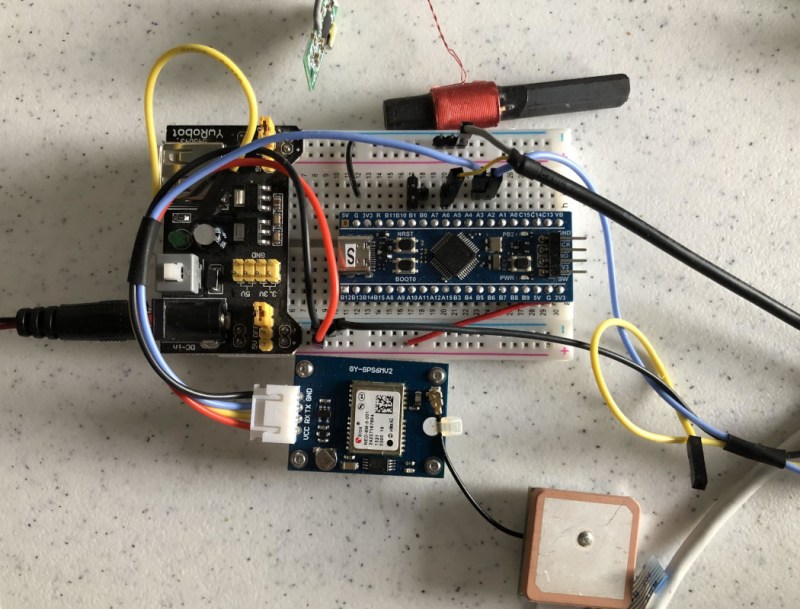As far as timekeeping goes, there’s nothing more accurate and precise than an atomic clock. Unfortunately, we can’t all have blocks of cesium in our basements, so various agencies around the world have maintained radio stations which, combined with an on-site atomic clock, send out timekeeping signals over the air. In the United States, this is the WWVB station located in Colorado which is generally receivable anywhere in the US but can be hard to hear on the East Coast. That’s why [JonMackey], who lives in northern New Hampshire, built this WWVB simulator.
Normally, clocks built to synchronize with the WWVB station include a small radio antenna to receive the 60 kHz signal and the 1-bit-per-second data transmission which is then decoded and used to update the time shown on the clock. Most of these clocks have internal (but much less precise) timekeeping circuitry to keep themselves going if they lose this signal, but [JonMackey] can go several days without his clocks hearing it. To make up for that he built a small transmitter that generates the proper timekeeping code for his clocks. The system is based on an STM32 which receives its time from GPS and broadcasts it on the correct frequency so that these clocks can get updates.
The small radio transmitter is built using one of the pins on the STM32 using PWM to get its frequency exactly at 60 kHz, which then can have the data modulated onto it. The radiating area is much less than a meter, so this isn’t likely to upset any neighbors, NIST, or the FCC, and the clocks need to be right beside it to update. Part of the reason why range is so limited is that very low frequency (VLF) radios typically require enormous antennas to be useful, so if you want to listen to more than timekeeping standards you’ll need a little bit of gear.
















It can be very interesting to feed one of these clocks impossible time signals. For example, 12:74 or 43rd January. In some cases, it crashes them, in others, it enters a parallel reality of timekeeping.
Great project, it’s also real interesting discovering just how far those fake time signals can propagate with only a milliwatt or two of power and the FCC just *love* hearing all about your problems with reception.
This is a cool project and I’ve considered doing something similar for the Japanese time signal. That said, if you just want to set a radio-controller clock, one of the easiest ways is using a phone app that produces a tone that is a harmonic of the needed frequency. It doesn’t sound like it would work, but it totally works.
Probably creating a strong enough magnetic field from the speaker to induce a signal in the coil.
I’ve also seen it done with software on a PC using the headphone cable as the antenna. You can output a 20KHz signal from a sound card and the clock will receive the third harmonic of it. The clock receivers are extremely sensitive so it doesn’t take much power.
It would be useful to build one of these for MSF 60 kHz to use in London UK where the signal is too weak for radio controlled clocks since they moved the transmitter from the British Midlands to the Scottish borders. I imagine that feeding the signal into mains wiring like networking over the mains would work well to feed the signal to clocks around the house without causing problems with stray radiation or an electrically short antenna because it would work by purely magnetic coupling to the magnetic loop stick antenna in the clock.
In Europe time signals is on 77 KHz named DCF. So you need to change software
DCF is but one of many in Europe.
It’s in Cumbria, so still England but admittedly only just, and much more central for the British Isles as a whole than when it was at Rugby. It seems pretty useless at its new location though, even in the North West.
I actually think a big problem nowadays is the massive amount of VLF noise from having a house full of switch-mode power supplies. The noise floor is just too high for resolving such a simple on-off keyed signal.
This is cool! I’ve been playing with a round display to show the WWVB time code signal. decoding and clock recovery aren’t done yet but it should be fun: MicroPython esp32 series https://github.com/wa5znu/clockish
See if you can make one based on my quantum time broadcast system at http://www.unifiedtime.org it’s 02053, AQT btw, atomic time is so yesterday.
That’s the most tin foil hat site I’d ever seen… I should probably wipe my phone and browser now.
I’ve set up a Pi Zero W with https://github.com/hzeller/txtempus
It takes in NTP, and it can put out DCF77, WWVB, MSF, or JJY.
I use it every time I need to reset any of my “Atomic” clocks.
Would it be possible to supplement the PNT signals everyone uses from GPS for time sync? I know you’d probably not get much better than a “coarse” time sync with a 60hz time 1 bit per second radio tick, but it would be an interesting back up for more austere systems that can’t always reach a NIST server.